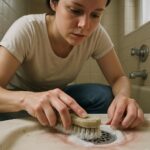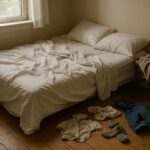It’s natural to be concerned after finding mold in your house, but you don’t have to be. Maintaining a clean and pest-free home is critical for the health of its occupants. You may successfully combat these unwanted visits if you arm yourself with the correct information and resources.
Hello there, and thank you for stopping by our house cleaning blog! We’ll go over why it’s critical to get rid of mold in your house right away. You can rely on the recommendations in our comprehensive guide to keep your home clean, healthy, and mold-free. Let’s get started right away!
What is Mold?
Excess moisture could be the cause of a common house problem: mold. Mold is basically a fungus that flourishes in moist environments and can be hazardous if not eradicated. Fungal growth is visible as patches or spots due to hyphae. Which are multicellular threads. Mold spreads through the release of spores into the air and can be a source of irritation in almost all households that it’s found in.
If you want to preserve a clean and healthy indoor environment free of mold, you have to take quick precautions and preventive measures. The first step is to identify that the stains appearing in your home are mold or not. When the conditions are favorable for mold growth, you will see mold in different colors. Hues such as black, green, white, and orange may appear so you should be on the lookout and act fast so it doesn’t spread.
Understanding Mold
Mold is one of the major causes of property damage and it thrives in damp environments. It’s an airborne fungal infection that can be dangerous if left untreated. Mold may grow on a variety of materials, including wood, textiles, and drywall, making it a typical home concern. It also affects humans; particularly vulnerable are those with compromised immune systems or mold allergies. While some molds are harmless, some may cause serious health problems.
The Types of Molds in Houses and How to Remove Them
Knowledge is power indeed when it comes to the battle against mold in the home. Everyone should be familiar with the numerous molds that might colonize your house, office, shop, etc. to know how to get rid of mold effectively. To maintain your home clean and free of health hazards, you should be aware of the habits of common pests and the most effective ways to get rid of them. You can also ask for help from professional cleaning companies like My Cleaning Angel.
Let’s discuss the various household molds and the best ways to get rid of them efficiently.
Identifying Common Types of Household Mold
Mold identification is the first step in mounting an effective defense against it. Fuzzy or slimy growths, varying in color from green to black, are common mold symptoms. A musty odor might be produced. You should take action if you see any of these symptoms.

Aspergillus
In houses, Aspergillus mould is a common issue. given that it can survive in air conditioners and on food. Unexpectedly, some food products are also made using this kind of mould.
For this type of mould, colours like green, blue-green, and grey are typical. Mould comes in a wide variety of forms, and some of them have the ability to spew spores into the atmosphere. A fungus called Aspergillus can seriously harm people who already have weakened immune systems or long-term respiratory conditions.
Certain Aspergillus species, such Aspergillus oryzae, are employed in the production of food. Aspergillus can induce respiratory issues in different contexts, such as miso and soy sauce.
Cladosporium
Unlike most other moulds, Cladosporium thrives in cooler climates with low relative humidity. This kind of mould can grow almost anywhere, including under floors, on wood, on carpets, and on upholstered furniture. Cladosporium is a typical annoyance in homes. Spots of black or olive green are a common type of distinguishing characteristic. Airborne Cladosporium spores have been associated with a range of allergic reactions, including sinusitis, dermatitis, pneumonia, and even pulmonary emphysema.
Penicillium
Penicillium is common on wet surfaces. Water-damaged wallpaper, insulation, and carpets are common breeding grounds for the blue or green mold Penicillium. It often induces an allergic response in some people and spreads rapidly. There are more than 200 recognized species of Penicillium. Some are used to make cheese or antibiotics (such Penicillium chrysogenum, from which penicillin is derived). However, persistent sinusitis or allergic lung irritation may be caused by mycotoxins produced by some species of Penicillium.
Stachybotrys Chartarum
Commonly referred to as “black mold,” Stachybotrys Chartarum is a toxigenic mold that can trigger health problems because to the mycotoxins it generates. This mold, which is often greenish-black in color and has a slimy feel, thrives in humid places like restrooms and laundry rooms. Any contact to this type of mold can result in chronic sinus infections, persistent coughing, headaches, exhaustion, and even neurological issues or immunological suppression. You have to get rid of the mold in any form.

How to Remove Common Types of Household Mold
There may be some variation in strategy depending on the specific species of mold at hand. However, the following tips and tricks can be initially applied to remove these pesky invaders. These should serve as a good jumping off point for eliminating any type of mold.
Aspergillus Removal
Frequent cleaning and maintenance may eliminate aspergillus. A fungus often found in HVAC systems and on food. If you practice routine filter replacements and yearly expert maintenance, mold development in air conditioning systems can be significantly reduced. If you see Aspergillus on food, throw it away immediately.
Use a mold-killing substance, such as a bleach-based cleanser, on the surfaces in your house. After the cleanser has had time to do its job on the mold, it should be scrubbed off completely. To prevent mold growth from returning, make sure to rinse and dry the area thoroughly.
Cladosporium Removal
Cladosporium is a common fungus that lives on fabrics and wood. Maintaining low Cladosporium counts in carpets and furniture can be accomplished by regular vacuuming. To clean wood, just wipe it off with water and a little detergent and let it air dry. Bleach may stain wood, so it’s best to avoid it.
If Cladosporium is discovered in the subfloor, it may be required to have the area professionally remedied by services like My Cleaning Angel.
Penicillium Removal
The best course of action, if Penicillium is found on wallpaper, insulation, or carpets, is to remove and replace them. Mold on hard surfaces may be killed and removed using a bleach-based cleaning. Always ensure a complete drying process after cleaning.
Stachybotrys Chartarum (Black Mold) Removal
The health dangers linked with black mold make it imperative that you get expert aid if you discover it in your home.
Avoid disturbing the mold, since doing so might release spores into the air and increase the health hazards. Only trained remediation specialists, armed with the proper safety gear and knowledge, should attempt to eradicate this mold.
If the area of mold development is big or if you are unable to deal with it, it is better to seek expert assistance. They will not only be able to remove the mold in a safe and efficient manner, but will also be able to locate and eliminate the water problem that is causing it.

People Also Ask
How to get rid of mold?
It is imperative that you take all the required safety measures before starting the mould eradication process. Always wear protective clothing, such as goggles, a mask, and gloves, to prevent contracting an illness from mould spores.
Step by Step: How to Get Rid of Mold?
-
Step 1: Cleaning the Mold
Try using a solution of one part bleach to ten parts water to get rid of the mould. Apply the solution and completely clean the area with a sponge or cloth. Make sure there is adequate ventilation in the room before handling bleach.
-
Step 2: Rinsing the Area
After cleaning, rinse the area with warm water. Because bleach residue is hazardous, it needs to be completely removed from the surface.
-
Step 3: Drying the Area
Use a fresh towel to ensure the area is fully dry. Remember that mould thrives in moist environments, thus it’s imperative to dry them out.
How do I get rid of the mold from porous surfaces?
It’s more difficult if the mold penetrated porous materials like carpets or walls. To guarantee full mold eradication, these materials must often be replaced.
How do I prevent future mold growth?
After it has been eliminated, the problem at hand is preventing mould. Make sure there is adequate airflow and ventilation, seal any leaks you detect, and use a dehumidifier in any rooms that are too damp.
When do I call the professionals to remove mold?
If the mould has spread widely, penetrated your HVAC system, or you are concerned about your health, you should contact a professional. They have the knowledge and experience necessary to safely and effectively address extensive mould problems.

Conclusion
In conclusion, removing mold might seem like a difficult task, but it is possible with the appropriate approach. Remember that the most important thing is to react quickly, clean completely, and take precautions to avoid further development.
Book cleaning services online now with My Cleaning Angel, it’s easy and fast.







